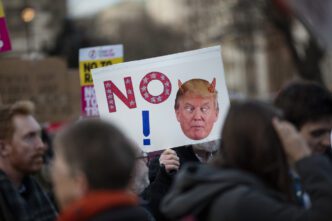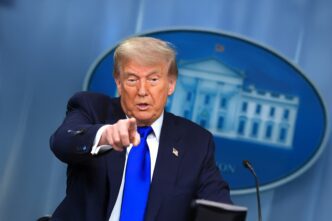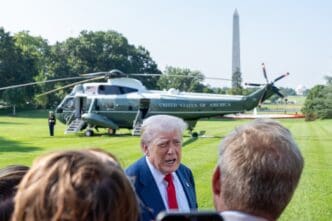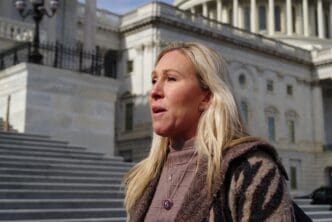Executive Summary
The Story So Far
Why This Matters
Who Thinks What?
US President Donald Trump faced widespread public protests and symbolic displays of disapproval across the United Kingdom this week, even as he was officially welcomed by the British royal family in a lavish ceremony at Windsor Castle on Wednesday. Demonstrations, which began Tuesday evening, highlighted broad public discontent with Trump’s visit, with UK authorities reportedly keen to keep the American leader away from overt public criticism.
Public Sentiment and Initial Protests
Recent polling indicates significant public disapproval of President Trump in Britain. An Ipsos poll published Tuesday revealed that 61% of Britons hold unfavorable views of the US leader. Anti-Trump demonstrations commenced shortly after his arrival at London’s Stansted Airport on Tuesday evening.
That same evening, activist group Led By Donkeys projected footage of Trump alongside convicted sex offender Jeffrey Epstein onto the side of Windsor Castle. The group, which posted the stunt on Instagram, called it “The story of Trump and Epstein.” Four men were subsequently arrested on suspicion of “malicious communications” in connection with the demonstration.
London Demonstrations and Official Shielding
On Wednesday, as President Trump traveled to Windsor for official engagements, protests intensified in London. Critics observed that local authorities appeared to shield Trump from public admonishment, with all scheduled events held behind closed doors amid heavy security.
Demonstrators gathered in the British capital, brandishing signs and flags with anti-Trump slogans. Some participants dressed as figures such as Russian President Vladimir Putin, Israeli Prime Minister Benjamin Netanyahu, and Andrew Tate, holding signs that read “war criminals for Trump,” “murderers for Trump,” and “misogynists for Trump.” Many signs also addressed specific political topics, including the Russia-Ukraine conflict and Israel’s war in Gaza.
Ben Jamal, director of the Palestine Solidarity Campaign, told CNN at the protest that their broad reasons for demonstrating stemmed from “the politics that Donald Trump represents, politics of racism, the politics of division and hatred, politics that puts profit before the planet… are the absolute antithesis of the politics that we represent.”
London Mayor Sadiq Khan echoed these sentiments in an op-ed for The Guardian, accusing Trump of “fanning the flames of divisive, far-right politics around the world” and urging Londoners to reject his “politics of fear and division.”
Media and Ongoing Schedule
British television network Channel 4 also weighed in, broadcasting a five-hour program titled “Trump v The Truth” on Wednesday evening. The program reportedly showcased over 100 “falsehoods, distortions and inaccuracies uttered or written by the US President.”
President Trump is expected to continue to steer clear of the British public on Thursday, with plans to travel to Chequers for talks with Keir Starmer.
Key Takeaways
President Trump’s visit to the UK has been characterized by a stark contrast between official diplomatic welcomes and widespread public disapproval, manifested through various forms of protest and media scrutiny. The demonstrations underscore significant public opposition to his policies and rhetoric, with critics citing concerns ranging from racism and division to specific international conflicts.








